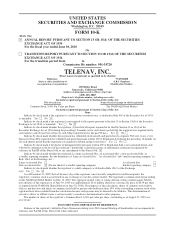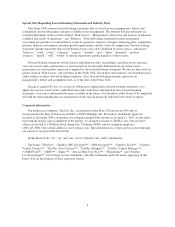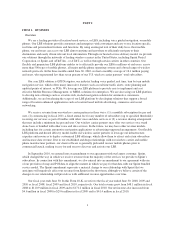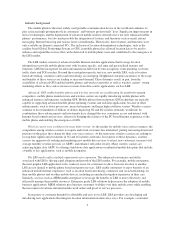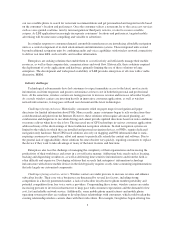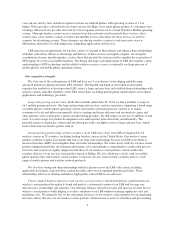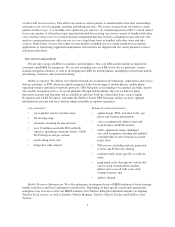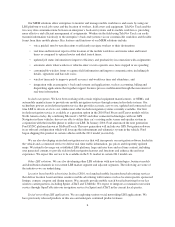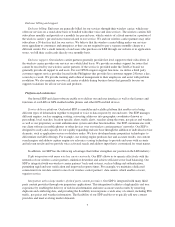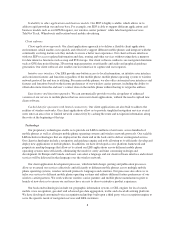TeleNav 2010 Annual Report Download - page 7
Download and view the complete annual report
Please find page 7 of the 2010 TeleNav annual report below. You can navigate through the pages in the report by either clicking on the pages listed below, or by using the keyword search tool below to find specific information within the annual report.voice driven, turn by turn, mobile navigation software on Android phones with operating systems of 1.6 or
higher. Nokia provides a download for its latest version Ovi Maps on its smart phone products to consumers free
of charge. Microsoft also provides free turn by turn navigation software on its current Windows Mobile operating
system. Although wireless carriers receive revenue from data networks used to provide these services, these
services may cause wireless carriers to reduce the monthly fees to subscribers for these services in order to
compete for advertising revenue. These dynamics are driving wireless carriers to seek innovative ways to
differentiate themselves by delivering more compelling applications and services.
LBS represent an opportunity for wireless carriers to respond to these threats and enhance their relationships
with their subscribers. However, the design and delivery of these services are highly complex, involving the
coordination of many unrelated parties, such as those that provide the systems used to expedite the acquisition of
GPS signals by receivers in mobile handsets. The design and large scale deployment of LBS also requires a deep
understanding of GPS technology and the ability to deliver services across a continually evolving universe of
mobile phones and mobile phone operating systems.
Our competitive strengths
We were one of the early pioneers in LBS and have an 11-year history of developing and delivering
advanced mobile navigation and other LBS solutions. The breadth and depth of our technical and market
expertise has enabled us to develop robust LBS, attract a large end user base and establish deep relationships with
wireless carriers and other members of the LBS value chain, including mobile phone manufacturers and content,
applications and technology providers.
Large and growing end user base. In the three months ended June 30, 2010, we had a monthly average of
16.1 million paying end users. Our large and growing end user base, and our experience supporting a broad range
of mobile phones, mobile phone operating systems and wireless network protocols, enables us to realize
economies of scale and deliver incremental value to existing and future end users and our wireless carrier and
other partners, such as third party content and advertising providers. By delivering our services to millions of end
users, we can leverage our product development costs and expertise more effectively and efficiently. The
potential returns to third party content and advertising providers are higher across a larger end user base, which
makes them more inclined to partner with us.
Strong and deep partnerships with key members of the LBS value chain. Our LBS are deployed by 14
wireless carriers in 29 countries, including leading wireless carriers in the United States. Our wireless carrier
partners continue to make investments that foster our long term relationships because our LBS assist them to
increase their data ARPU and strengthen their subscriber relationships. We work closely with our wireless carrier
partners during their product development and testing cycles and undergo a comprehensive certification process.
Our back-end systems are tightly integrated with those of our wireless carrier partners, which enables the
seamless delivery of our services from product launch to billing. We also collaborate closely with our mobile
phone manufacturer and wireless carrier partners so that our services work in many countries and on a wide
range of mobile phones and wireless network protocols.
We also have strong and deep relationships with key players across the LBS value chain, including
application developers, map and other content providers and voice recognition platform providers. These
relationships allow us to develop and deliver high quality, robust LBS to our end users.
Closely aligned business objectives with wireless carrier partners. Our hosted delivery model enables our
wireless carrier partners the option to brand and market a customized version of our LBS and leverage our
infrastructure, partnerships and expertise. Our offerings enhance subscriber loyalty and increase revenue for our
wireless carrier partners while helping us to drive adoption of our LBS without incurring significant sales and
marketing costs. We primarily rely on the substantial resources of our wireless carrier partners for our marketing
and sales efforts. We also use our wireless carrier partners’ infrastructure to assist in validation and provisioning
4

